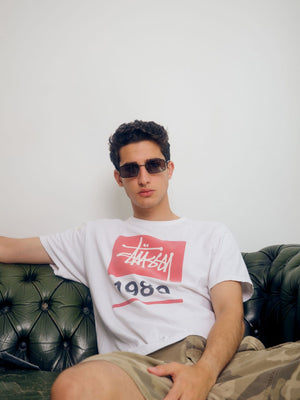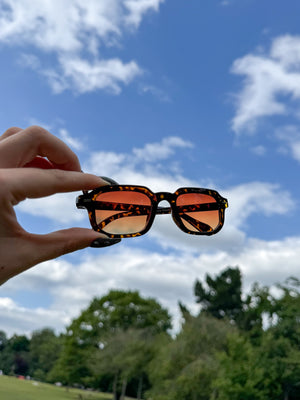
A History Of Adidas
Posted by Coco Brown on

Adidas Billboard // via Quartz Media
When you’ve got Kanye West and Stella McCartney collaborating with you, you know your brand is having a moment - and Adidas is that brand. But if you know Adidas’s long history, its current success comes as no surprise. Adidas has gone from purely producing athletic footwear, to having its apparel and shoes intertwined with popular culture. That famous trefoil logo has come a long way - and only stands to be more successful in the future.
Brothers Rudolf and Adolf Dassler created Gebrüder Dassler Schuhfabrik (Dassler Brothers Shoe Factory) together in their small Bavarian hometown in 1924. Their mission? To create athletic shoes based on their own experiences as accomplished amateur athletes. In 1936, Adolf drove to Olympic Village, spikes in tow, hoping to convince Olympic athletes to wear their shoes. He won over sprinter Jesse Owens with a pair of remarkably light shoes with handmade spikes- the first athletic sponsorship for an African American. When Jesse Owens won gold at the 1936 Berlin Olympics, athletes worldwide were asking after the Dassler’s shoes.

Jesse Owens at the 1936 Olympics // via The Daily Mail
After many disagreements during WWII, the Dassler brothers went their separate ways. Rudolf would go on to form Puma, while Adolf created a portmanteau of his nickname, “Adi”, and his surname, “Dassler”, to create “Adidas”, which he officially registered in 1949. In 1952, Adidas acquired its signature three bars logo from another company for the equivalent of €1600 and two bottles of whiskey.

Adi Dassler with an Athlete // via adidas-group.com
Adidas became a household name when the German national football team won the 1954 World Cup final- several members of the team were wearing Adidas shoes. Germany’s unlikely win against Hungary catapulted both the German National team and Adidas into the international spotlight.



The 80s ushered in a fitness craze, with athleticwear becoming not only practical, but fashionable, as better tailoring and synthetic fabrics like Gore-Tex became popular. But jazzercise wasn’t the only area where Adidas shined. Hip hop stars were remaking the reputation of Adidas. The tracksuits were easy to dance in, and the bright colors and graphics suited the bold stylings of hip hop. American hip hop group Run DMC even released a song called “my adidas.” At a concert, the band held up Adidas shoes in front of a crowd of 40,000 fans. Adidas became street fashion approved, and with one of the first non-athletic sponsorships for a sportswear brand.
The early 90s brought financial trouble to the Adidas corporation. Horst Dassler’s death left the company with questionable leadership and the company suffered historic losses in 1992. After Robert Louis-Dreyfus took the helm, Adidas was back on track. Some of Adidas’s most classic shoes were made or reissued during this period, including the Gazelle, which was favored by models, Britpop stars, and hip hop musicians. Adidas became a favorite of stars like Jay-Z and Diddy, who solidified the concept of being so wealthy you didn’t need to “get dressed.” The soccer-centric casual audience in the UK also loved Adidas, which was fashionable and accessible.

Kate Moss in Adidas Gazelles // 1993 // via Business of Fashion
Adidas has boomed in the 2000s. The company sought out collaborations with fashion moguls like Stella McCartney, Mary Katrantzou, and even Kanye West. The tracksuit has been making a comeback in the Grime scene, and the casual lifestyle that Adidas promotes is more desirable than ever. From a tiny town in Bavaria to defining the athleisure wave, Adidas has come of age, and has a bright future of accessible fashion ahead of it.
Julia Norton
Sources
Adidas Billboard // via Quartz Media //
https://qz.com/927658/adidas-is-gaining-on-nike-in-the-us-through-fashion-and-speed/
Jesse Owens at the 1936 Olympics // via The Daily Mail // http://www.dailymail.co.uk/home/moslive/article-2175334/Olympic-history-Jesse-Owens-Daley-Thompson-shoes-took-athletes-podium.html
Players in Adias before the World Cup Final // via worldcupballs.info // http://worldcupballs.info/world-cup-balls/1954-switzerland/1954-world-cup-ball-swiss-world-champion.html
Adi Dassler with an Athlete // via adidas-group.com //
http://www.adidas-group.com/en/group/history/
The Franz Beckenbauer Tracksuit // 1967 // via adidas-group.com // http://www.adidas-group.com/en/group/history/
1979 Adidas Ad // via Pinterest // https://www.pinterest.com/lepton11/adidas-vintage/
Kate Moss in Adidas Gazelles // 1993 // via Business of Fashion // https://www.businessoffashion.com/articles/bof-exclusive/adidas-gazelle-kate-moss





